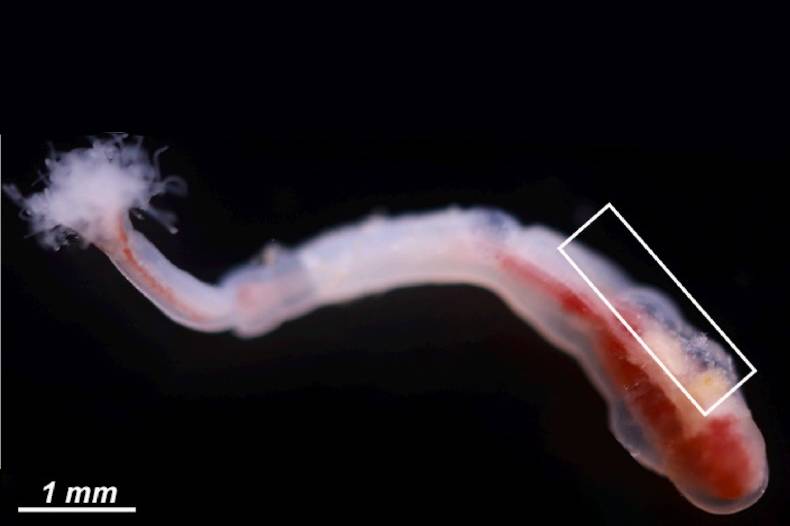Russian Scientists Have Studied Marine Worm with Unique Spermatozoa

Russian scientists at A.V. Zhirmunsky National Scientific Centre of Marine Biology, HSE University, and Moscow State University have studied Phoronis embryolabi, a rare species of marine invertebrate found in the waters of the Sea of Japan. This species is notable for its unique reproductive system, which includes the development of larvae within the parent’s body and an unusual sperm structure. The study's findings contribute to our understanding of the evolutionary adaptations of marine organisms to extreme conditions. The study has been published in Zoologischer Anzeiger.
Phoronis embryolabi is a small marine worm that is viviparous, meaning it gives birth to live young, with larvae developing inside the parent’s body. This is an important adaptation for Phoronis embryolabi, which lives as a commensal organism—a type of symbiotic relationship where the commensal benefits while the host remains unaffected—in the holes of burrowing shrimp. It has been discovered that the reproductive process in this species involves the formation of spermatozoa with an unusual structure.
Spermatozoa are filamentous cells capable of moving within the confined spaces of the body. They develop in vasoperitoneal tissue (VPT) that surrounds blood vessels. 'This structure enables spermatozoa to move efficiently through narrow spaces filled with cells and embryos,' according to Elena Temereva, Professor of the Joint Department with RAS Shemyakin-Ovchinnikov Institute of Bioorganic Chemistry, HSE Faculty of Biology and Biotechnology.
Unlike other phoronid species, whose spermatozoa are V-shaped, Phoronis embryolabi’s spermatozoa maintain an elongated shape throughout all stages of maturity. The flagellum, essential for movement, is closely aligned with the cell body, which aids in movement through the narrow spaces of the body cavity. This is important, because the numerous embryos and other cells developing inside the body create additional challenges for sperm movement.
Sperm cells in Phoronis embryolabi, known as introsperm, possess unique adaptations typical of species with internal fertilisation. To reach the eggs, they must navigate through dense layers of cells and squeeze in the narrow spaces within the body. The researchers found that these spermatozoa are equipped with a collar around the base of the flagellum, which, along with undulating movements, enables them to move through the densely packed inner spaces of the animal. This movement resembles that of certain single-cell parasites, such as trypanosomes, which use similar mechanisms to move through a viscous medium.
For comparison, in other phoronid species, such as Phoronis pallida and Phoronopsis harmeri, introsperm are V-shaped cells composed of two parts: one part is the flagellum, while the other contains the nucleus and mitochondria. In Phoronis embryolabi, all components of the sperm are closely interconnected, which enhances their ability to move efficiently through narrow spaces. In addition, their spermatozoa are shorter than those of other species, which may also be an adaptation to the habitat conditions.
The study of spermatogenesis and sperm structure in Phoronis embryolabi provides valuable insights into how organisms adapt to extreme conditions. This information helps deepen our understanding of the evolution of reproductive biology in marine invertebrates and the factors that have influenced the development of complex reproductive strategies.
The unique adaptations of spermatozoa in Phoronis embryolabi are a crucial component of this species' survival strategy. The ability to move through narrow spaces and fertilise eggs in a body filled with embryos and other cells is an example of a successful evolutionary adaptation.
The research was carried out with support from the Russian Science Foundation.
See also:
Scientists Rank Russian Regions by Climate Risk Levels
Researchers from HSE University and the Russian Academy of Sciences have assessed the levels of climate risks across Russian regions. Using five key climate risks—heatwaves, water stress, wildfires, extreme precipitation, and permafrost degradation—the scientists ranked the country’s regions according to their need for adaptation to climate change. Krasnoyarsk Krai, Irkutsk Region, and Sverdlovsk Region rank among the highest for four of the five climate risks considered. The study has been published in Science of the Total Environment.
HSE Researchers Teach Neural Network to Distinguish Origins from Genetically Similar Populations
Researchers from the AI and Digital Science Institute, HSE Faculty of Computer Science, have proposed a new approach based on advanced machine learning techniques to determine a person’s genetic origin with high accuracy. This method uses graph neural networks, which make it possible to distinguish even very closely related populations.
HSE Economists Reveal the Secret to Strong Families
Researchers from the HSE Faculty of Economic Sciences have examined the key factors behind lasting marriages. The findings show that having children is the primary factor contributing to marital stability, while for couples without children, a greater income gap between spouses is associated with a stronger union. This is the conclusion reported in Applied Econometrics.
Fifteen Minutes on Foot: How Post-Soviet Cities Manage Access to Essential Services
Researchers from HSE University and the Institute of Geography of the Russian Academy of Sciences analysed three major Russian cities to assess their alignment with the '15-minute city' concept—an urban design that ensures residents can easily access essential services and facilities within walking distance. Naberezhnye Chelny, where most residents live in Soviet-era microdistricts, demonstrated the highest levels of accessibility. In Krasnodar, fewer than half of residents can easily reach essential facilities on foot, and in Saratov, just over a third can. The article has been published in Regional Research of Russia.
HSE Researchers Find Counter-Strike Skins Outperform Bitcoin and Gold as Alternative Investments
Virtual knives, custom-painted machine guns, and gloves are common collectible items in videogames. A new study by scientists from HSE University suggests that digital skins from the popular video game Counter-Strike: Global Offensive (CS:GO) rank among the most profitable types of alternative investments, with average annual returns exceeding 40%. The study has been published in the Social Science Research Network (SSRN), a free-access online repository.
HSE Neurolinguists Reveal What Makes Apps Effective for Aphasia Rehabilitation
Scientists at the HSE Centre for Language and Brain have identified key factors that increase the effectiveness of mobile and computer-based applications for aphasia rehabilitation. These key factors include automated feedback, a variety of tasks within the application, extended treatment duration, and ongoing interaction between the user and the clinician. The article has been published in NeuroRehabilitation.
'Our Goal Is Not to Determine Which Version Is Correct but to Explore the Variability'
The International Linguistic Convergence Laboratory at the HSE Faculty of Humanities studies the processes of convergence among languages spoken in regions with mixed, multiethnic populations. Research conducted by linguists at HSE University contributes to understanding the history of language development and explores how languages are perceived and used in multilingual environments. George Moroz, head of the laboratory, shares more details in an interview with the HSE News Service.
Slim vs Fat: Overweight Russians Earn Less
Overweight Russians tend to earn significantly less than their slimmer counterparts, with a 10% increase in body mass index (BMI) associated with a 9% decrease in wages. These are the findings made by Anastasiia Deeva, lecturer at the HSE Faculty of Economic Sciences and intern researcher in Laboratory of Economic Research in Public Sector. The article has been published in Voprosy Statistiki.
Scientists Reveal Cognitive Mechanisms Involved in Bipolar Disorder
An international team of researchers including scientists from HSE University has experimentally demonstrated that individuals with bipolar disorder tend to perceive the world as more volatile than it actually is, which often leads them to make irrational decisions. The scientists suggest that their findings could lead to the development of more accurate methods for diagnosing and treating bipolar disorder in the future. The article has been published in Translational Psychiatry.
Scientists Develop AI Tool for Designing Novel Materials
An international team of scientists, including researchers from HSE University, has developed a new generative model called the Wyckoff Transformer (WyFormer) for creating symmetrical crystal structures. The neural network will make it possible to design materials with specified properties for use in semiconductors, solar panels, medical devices, and other high-tech applications. The scientists will present their work at ICML, a leading international conference on machine learning, on July 15 in Vancouver. A preprint of the paper is available on arxiv.org, with the code and data released under an open-source license.



